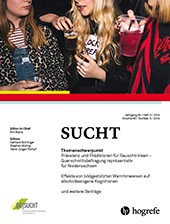Effekte einer 6-sekündigen Präsentation von bildgestützten Warnhinweisen auf implizite und explizite alkoholbezogene Kognitionen von Jugendlichen
Effects of a 6-second presentation of pictorial warning labels on implicit and explicit alcohol-specific cognitions of adolescents
Abstract
Zusammenfassung.Ziel: Es wurde untersucht, welche unmittelbaren Wirkungen alkoholbezogene Warnhinweise auf Jugendliche haben. Methodik: Zwei experimentelle Online-Studien mit insgesamt 2.497 Jugendlichen und jungen Erwachsenen zwischen 13 und 19 Jahren. In beiden Studien wurde vor dem Ausfüllen eines Fragebogens für 6 Sekunden ein Bild präsentiert, das per Zufall aus drei Kategorien stammte: a) jugendspezifischer Warnhinweis b) konventioneller nicht-jugendspezifischer Warnhinweis sowie c) „neutrales“ Foto ohne Alkoholbezug. Als direkte Maße wurden alkoholbezogene Einstellungen und Trinkintentionen erfasst (Studie 1), als indirekte Maße der implizite Affekt, soziale Normen und allgemeine (inkl. alkohol-bezogene) Risikoeinschätzungen (Studie 2). Ergebnisse: Nach Exposition mit einem konventionellen Warnhinweis schätzten die Befragten die Wahrscheinlichkeit höher ein, am nächsten Wochenende fünf oder mehr alkoholische Getränke zu konsumieren als in den beiden anderen Bedingungen (Studie 1). Befragte der Bedingung „jugendspezifischer Warnhinweis“ hatten eine insgesamt höhere Risikowahrnehmung und schätzten die Risiken des Alkoholkonsums als höher ein als Befragte der beiden anderen Bedingungen (Studie 2). Keine Unterschiede ergaben sich bei alkoholbezogenen Einstellungen (Studie 1). Schlussfolgerungen: Bereits eine sehr kurze Exposition mit bildgestützten Warnhinweisen über Alkohol scheinen messbare Effekte auf Kognitionen von Jugendlichen und jungen Erwachsenen auslösen zu können.
Abstract.Aim: To study the immediate effects of alcohol-related warning messages on adolescents. Methods: Two single-factor experimental online studies with 2497 adolescent and young adults aged between 13 and 19 years. In both studies participants received a six seconds exposure to a stimulus before filling out a questionnaire. The stimulus was randomly drawn from three categories: a) youth-specific alcohol warning message; b) conventional picture-based warning label; c) neutral picture without any alcohol reference (control condition). Alcohol-related attitudes and intentions were assessed as direct measures (study 1), implicit affect, social norms, and general (incl. alcohol-specific) risk perceptions as indirect measures (study 2). Results: Exposure to a conventional warning label was associated with a higher subjective likelihood to drink five or more alcoholic beverages on the next weekend, compared to the other two experimental conditions (study 1). Participants in the condition “youth-specific warning message” reported higher general and alcohol-specific risk perceptions compared to participants in the condition „conventional warning label or the control condition (study 2). No differences between the experimental groups were found for alcohol-related attitudes (study 1). Conclusions: A short presentation of picture- and text-based alcohol-related messages seems to have measurable effects on cognitions of adolescents and young adults.
Literatur
(2017). Alcohol Warnings and Moderate Drinking Patterns among Italian University Students: An Exploratory Study. Nutrients, 9(6). doi: 10.3390/nu9060628
(2018). Informing drinkers: Can current UK alcohol labels be improved? Drug and Alcohol Dependence, 192, 163–170. doi: 10.1016/j.drugalcdep.2018.07.032
(1966). Experimental and quasi-experimental designs for research. Chicago: Rand McNally.
(2017). The influence of threatening visual warnings on tobacco packaging: Measuring the impact of threat level, image size, and type of pack through psychophysiological and self-report methods. PLoS One, 12(9), e0184415. doi: 10.1371/journal.pone.0184415
Eurocare . (2012). Library of Alcohol Health Warning Labels. https://webgate.ec.europa.eu/chafea_pdb/assets/files/.../20113208_d04-00_en_ps.pdf. Verfügbar unter: (Archiviert durch WebCite® auf http://www.webcitation.org/76cpGzUYX)(2018). Testing the Efficacy of Alcohol Labels with Standard Drink Information and National Drinking Guidelines on Consumers’ Ability to Estimate Alcohol Consumption. Alcohol & Alcoholism, 53(1), 3–11. doi: 10.1093/alcalc/agx052
(2016). Message on a bottle: are alcohol warning labels about cancer appropriate? BMC Public Health, 16, 139. doi: 10.1186/s12889-016-2812-8
(2016). The impact of strengthening cigarette pack warnings: Systematic review of longitudinal observational studies. Social Science & Medicine, 164, 118–129. doi: 10.1016/j.socscimed.2016.06.011
(2017). Der Alkoholkonsum Jugendlicher und junger Erwachsener in Deutschland. Ergebnisse des Alkoholsurveys 2016 und Trends. BZgA-Forschungsbericht. Köln: Bundeszentrale für gesundheitliche Aufklärung.
(2018). Alcohol Warning Label Awareness and Attention: A Multi-method Study. Alcohol & Alcoholism, 53(1), 39–45. doi: 10.1093/alcalc/agx087
(2009). When nonsense sounds happy or helpless: The Implicit Positive and Negative Affect Test (IPANAT). Journal of Personality and Social Psycholology, 97(3), 500–516. doi: 10.1037/a0016063
(2009). Global burden of disease and injury and economic cost attributable to alcohol use and alcohol-use disorders. Lancet, 373(9682), 2223–2233. doi: S0140-6736(09)60746-7
(2006). The psychology of self-defense: self-affirmation theory. Advances in Experimental Social Psychology, 38, 183–242.
(2018). Alcohol pictorial health warning labels: the impact of self-affirmation and health warning severity. BMC Public Health, 18(1), 1403. doi: 10.1186/s12889-018-6243-6
(2017). Alcohol health warnings can influence the speed of consumption. Zeitschrift für Gesundheitswissenschaften, 25(2), 147–154. doi: 10.1007/s10389-016-0770-3
(2016). Influences of Self-Efficacy, Response Efficacy, and Reactance on Responses to Cigarette Health Warnings: A Longitudinal Study of Adult Smokers in Australia and Canada. Health Commun, 31(12), 1517–1526. doi: 10.1080/10410236.2015.1089456
(2018). “We Have a Right to Know”: Exploring Consumer Opinions on Content, Design and Acceptability of Enhanced Alcohol Labels. Alcohol & Alcoholism, 53(1), 20–25. doi: 10.1093/alcalc/agx068
(2010). EmoPics: Subjektive und psychophysiologische Evaluation emotionalen Bildmaterials zur klinischen und biopsychologischen Forschung. Zeitschrift für Klinische Psychologie und Psychotherapie, 39(S1), 77.



